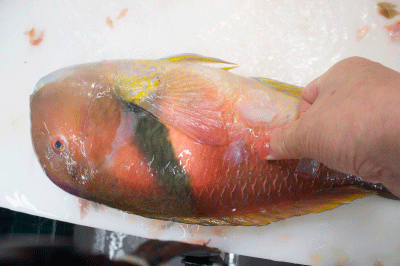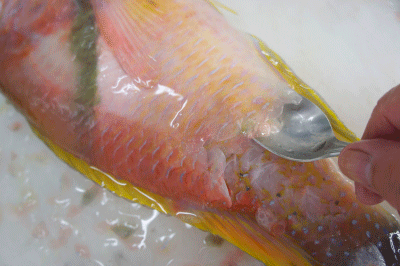| Please access the following URL if you want to secure using SSL. All pages in the site will be secure pages. |
| https://secure02.blue.shared-server.net/www.fish-food.co.jp/message english 8.2019.html |
Welcome to FISH FOOD TIMES
Aug. 2019 issue No.188

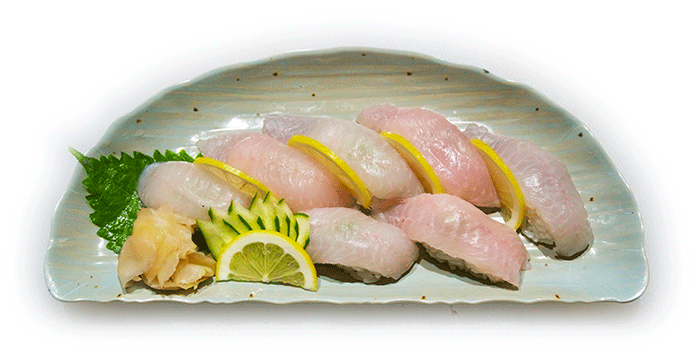
Wrasse sushi
Large blood group in the sea with 500 kinds of relatives
When buying wrasse to be dealt with in this month's edition, when I told the storeman that I wanted the wrasse, he immediately put on a bag as it was, and I finally stopped the movement. A bag full, but wrasse was cheap. Maybe he didn't have many wrasse buyers and he often had trouble selling them, so he tried to push a lot to people who would buy it. The fish called wrasse is not so popular.
The following image is the wrasse purchased at that time. The upper orange color is Percifomes order, Labroidei suborder, Labridae family, Pseudolabrus genus, Red naped wrasse, and the lower greenish ones are Percifomes order, Labroidei suborder, Labridae family, Pseudolabrus genus, Star bambooleaf wrasse in the same wrasse It is. In this way, it is another kind of different wrasse, but there is no fish shop that distinguishes it and sells it so far, both of them are accepted by wrasse.
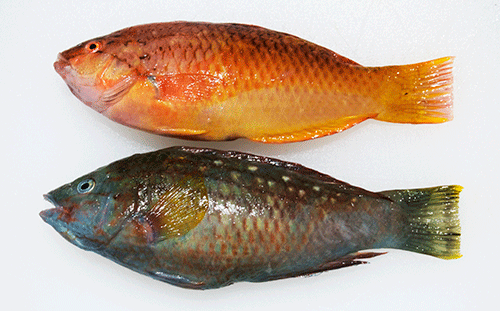
Similarly, the lower image is red bambooleaf wrasse at the top and star bambooleaf wrasse at the bottom, but even with the exact same fish species, the color and shape are slightly different. Not only that, there are various colors depending on the gender and the degree of growth, and you should not be surprised if there are any other color of wrasse.
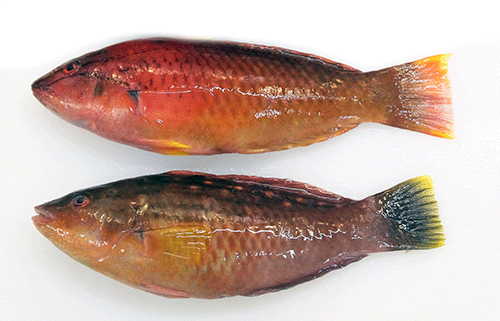
It seems that the various colors like this are related to the "harlem" of wrasse. The wrasse is a polygamy where males possess a territory and breed with multiple females who keep in the territory to envy. Wrasse is almost all female during childhood and growing, and has the characteristics of "female precocious" becoming sexually diversifying and becoming male when it grows, and to make harem when it becomes male and becomes male In addition, it is said that it becomes a flashy body color for attracting females.
As male wrasses fight vigorously between the males over securing the harem territory and females, smaller males do not have territory and there is less opportunity for reproduction. So, wrasse breeds as a female when it is small, and when it grows up to be large enough to hold a territory, and the male at the top of the harem dies for some reason, the harem's The biggest female inside is supposed to be sexually transformed to male.
The fish that perform this unique "female precocious" is the same as parrot fish, which is a Labroidei suborder that is a relative of wrasse. Certainly the flashy body color is the same as in the wrasse and parrot fish, and the fish surface is the same as the slimy mucous, and the same is the behavior in which it acts in the daytime and rests and sleeps in the night. The difference is a relatively small size of 10 cm to 30 cm, a small size of wrasse and parrot fish as large as 1 m in size, and eating habits of wrasse are carnivorous and parrot fish have different herbivory to eat seaweed attached to coral , Wrasse and parrot fish have many similar faces.
Experience of wrasse (multicolorfin rainbowfish) in Busan
The author visited Busan's Jagalchi fish market in October 2015. The state at that time is described in detail in No. 143 Difference in the fish meal across the sea (November, 2015 issue) and No. 143-2 Difference in the fish meal across the sea (November 2015 issue) ing. I want you to access and refer to this, but I had an interesting experience with wrasse (multicolorfin rainbowfish).
In the restaurant on the second floor of the Jagalchi Fish Market, I eat not only the wrasse in the image below, but also the fish such as long-armed octopus, sea squirt, kebulu and so on.
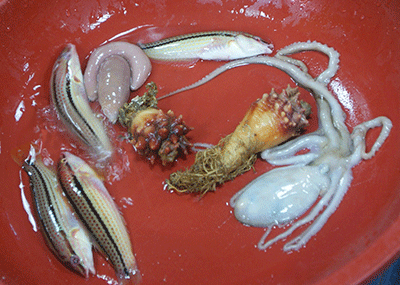
The event here was one of the harvests of travel in Korea. That's because the restaurant cooks were able to show with their own eyes the early work done at a speed of less than 2 minutes to cook four wrasse.
When the method referred to what to do, �@ placed on a cutting board the wrasse, a belly front, with the head to the right, to meuchi to eyeball portion. �A it puts the cut next to the gill lid of wrasse. As it is going to slide by the method of daimyooroshi technique the kitchen knife toward tail fin (you will be easy to understand and think of the manner of small horse mackerel) �B it does not complete the three pieces dismantling, to stop the knife at the brink of the tail fin, skin only that with, it turns over towards the left side of the tail fin. �C, the original of the body to the right, place the only remains that led the peel to the left, to separate the peel and the body is moved to the left as it is a kitchen knife in the manner of Uchibiki. �D in order to make the cooking of the upper body side now, towards the belly towards the other side, head remains right, repeating the same thing as before, three pieces dismantling and peel like is completed. �E it is the last in the end to take scooping the belly bone with a kitchen knife.
And to repeat the dismantling of four fish this, I've surprised because the two minutes did not take.
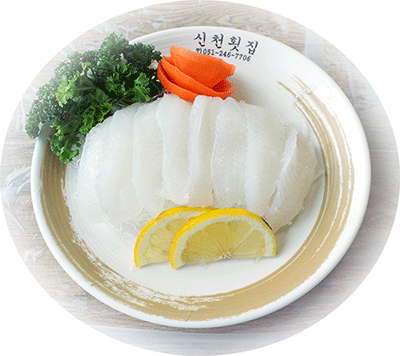
And the sashimi that has been given out is the upper image, and it was the best Japanese sashimi style in the ordered food. For the purpose of adding volume, the seaweed vidro artificial radish-like sashimi Tsuma piled up, and the half body wrasse (multicolorfin rainbowfish) was served as four half body on it.
Besides this, I decided to have FISH FOOD TIMES read the November 2015 issue of fish other than wrasse in Busan, and I will not write it here, but the speedy working method of the chef of the restaurant that I saw , I returned to Japan and decided to try it myself.
The image below is the speedy cooking method of wrasse that imitates the experience I saw in Busan, Korea.
| Wrasse skinless three pieces disassembling speedy cooking | |
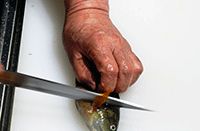 |
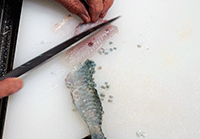 |
| 1�CWith the scale attached, turn the lower body of the wrasse upwards, place the head on the right and the abdomen on the near side, and make a straight cut with the yanagiba kitchen knife in the position next to the pectoral fin until the backbone. | 5�CRemove the skin-removed belly bone by moving it to the left with a yanagiba kitchen knife. |
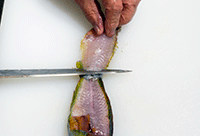 |
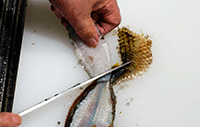 |
| 2�CFrom the cut, cut straight toward caudal fin by the method of daimyooroshi, and do not separate the root of the last caudal fin. | 6�CNext, with the upper body on top, head to the right, abdomen on the other side, separate the body and skin in the same way as you did in the lower body earlier, and finally remove the belly bone. |
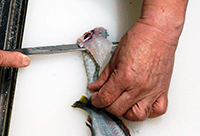 |
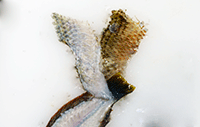 |
| 3�CWith the uncut body facing upwards, with the skin down, insert the blade of the yanagiba kitchen knife between the skin and the body and cut left. | 7�CThe state of the skin with the backbone and a scale with the backbone left behind. (Not shown in the image, but still with the head) |
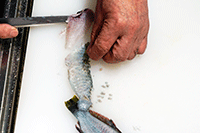 |
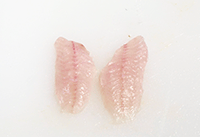 |
| 4�CCut the yanagiba kitchen knife left as it is and separate it from the skin. | 8�CSkinless, belly bone without wrasse |
This speedy cooking is dismantling work without removing scales, but the scales of the fish of Labridae family are very difficult to do by hand using a scale removal tool, but it is difficult to do by this cooking process I think that it is interesting to get over the hardness well.
It is difficult to remove the scales of the Labridae family
When dealing with parrot fish, tuskfish, and other members of the Labridae family, the first thing we struggle with is removing the scales. The scales are large, hard and firmly attached to the skin, so it is not easy to get them with the normal fish working method. So there are some interesting ways to come out of the experience of the author who has processed scales such as the parrot fish and tuskfish of the Labridae family, so let's touch this a little below.
This is an excerpt of the contents described in the past with No. 132 tuskfish sashimi (December, 2014 issue).
| How to easily remove the fishy scale of the Labridae family (example of tuskfish) |
This is a method of sliding your thumb under the scale and taking it. Although this method is arbitrarily named "thumb diving" by the author, if you push your thumb from the end near caudal fin so that it dives under the scales, several scales will be connected together come off.
If you use an ordinary tool for taking a scale, there is a risk that you will not leave a single scale attached to the skin, and you will leave the force and damage the fish meat, but with this method it is strange how many pieces continue comes off. However, there is one drawback to this method, which may cause your hands to be stabbed with spines on the fins, and in fact the author is stabbing with pain over and over again. So, the painful author next came up with a method to use the curry spoon found in every household as a thumb replacement.
Although the effect is not as great as with a thumb, it is definitely possible to work much more efficiently than using a scale removal tool. |
Now, let's write about something else about the fish of the Labridae family, as well as going sideways. That's because there was an event on July 8 just before that which triggered me to consider the theme of wrasse in this issue.
I work in Tsushima City, Nagasaki Prefecture, where I visit for two days each month. That night, I entered my favorite tavern "Sumikko", which is well-known for serving delicious dishes in Izuhara, Tsushima city. The shop is run by a couple, and Taisyo as well as Okami are very familiar with fish, and knowing that I am a fish consultant, they teach a lot about local fish. And while I was drinking, I had them learn about Tsushima's fish in good condition.
I went through it so many times and I was familiar, but this night it was very delicious for the first experience of cooking the image below at the end.
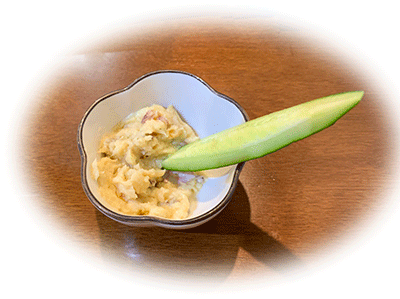
When I saw it, I thought it was a potato salad and I was told to eat cucumber like a spoon. So I guessed it was like Kinzanji miso and ate it, and it was so delicious with a little sweet and sour taste so I asked what it was like. I received a glance of disdain, "You don't even know such things ...?"
This was a dish called "kusabi miso" and the raw material was "wrasse", which is locally called kusabi. Although I ate for the first time in my life, it seemed to be one of the well-known soul foods in the local area, and Tsushima-born people were familiar fish dishes since childhood.
People around me verbally taught me the the auther who knows nothing about kusabi miso, but the drunken author could hardly remember anything. When I look back later, I found a document that Tsushima City had just released on the Internet in March of this year, so I would like to introduce it as it is.
| How to make kusabi miso |
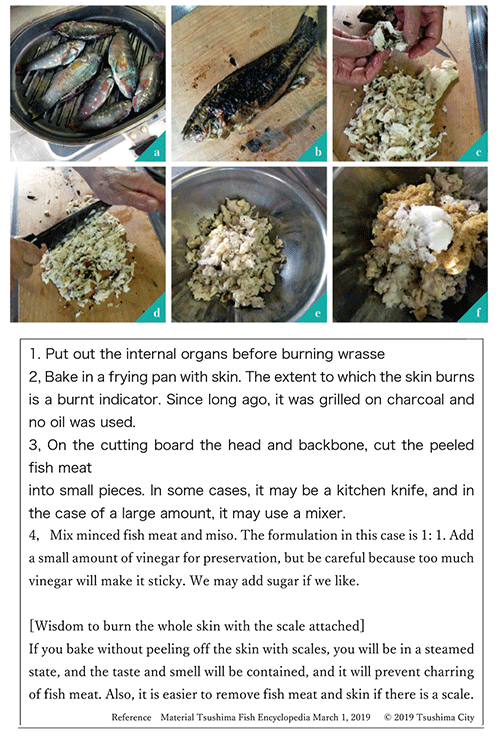 |
If you read the description of how to make this dish, you can understand that the existence of the scale is one of the points. I think that it is probably because it is steamed to keep taste and flavor locked up, to prevent charring, and to be easy to remove from the skin as reasons to keep the scale attached when baking wrasse. However, on the other hand, the author speculates that "the old people also know the difficulty of obtaining the wrasse's scale, and may have originally done some corner-cutting to avoid this".
Subtle differences in the color of fish meat
The wrasse can be easily made skinless three pieces disassembling by the speedy work method mentioned above. And when it's commercialized, it's a relatively cheap fish, so if it's small it can be a nigiri sushi with a half body. That is the product of the first page image.
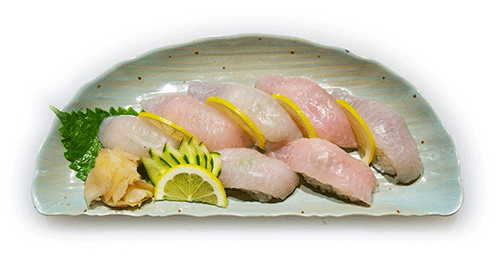
Since it is a nigiri sushi with half body, the surface of the subcutaneous body can be seen as it is. I think that it may be understood that the color of the fish meat of nigiri sushi put on the plate is reddish or whitish or slightly different. This is because the color of wrasse's skin is directly reflected in the color of the body, the reddish one is red on the fish surface and the whitish one is wrasse on which the fish surface is green.
This is the same as in the image below, and also for Usutsukuri sashimi, and the color difference between red and white is alternately arranged based on the difference in color, and the difference in color is intentionally used to commercialize it.
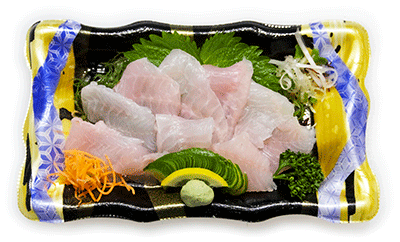
Such differences in color are also with the Scaridae family, and the color of the blue, green and red fish surfaces is also reflected in their color. However, blackspot tuskfish (Okinawa local name makubu), which is the finest fish of the same Labridae family, has no such phenomenon as color transfer, and is transparent and elegant white, which is also because it is a high-class fish felt. Similarly, multicolorfin rainbowfish, which is treated as a high class among wrasse's members, has clear whites, and why such features of blackspot tuskfish and multicolorfin rainbowfish are regarded as high class in the Labridae family It seems that.
Merchandise and Unused tendency of wrasse
Among the anglers, when wrasse is caught, there are only a few who release it, saying "oh ~ wrasse ...", and generally wrasse is treated as such a lower fish It is a poor fish to be positioned. Especially in the Kanto region, it is said that such a trend is strong, and in the Seto Inland Sea coastal region of western Japan, it seems that it will not be treated as steep as Kanto, but it is still a fish that can not be said to be very high.
As wrasse pinches the bait of the fishing line dropped by the angler with a small mouth, it seems that it may be intercepted by wrasse before the targeted fish can be caught. It is not a bad thing that a fisher hates wrasse is that it is delicious or not delicious, but there is a bad feeling that "Goddamn guy of wrasse, I've taken over bait again ..." It seems that he hates wrasse.
Also, another reason for anglers to hate wrasse is that although wrasse is not very large as the size of the fish, when you try to cook wrasse, gills lid is tightly closed and difficult to open, and the surface has a slimy mucus It is strong and difficult to handle, and furthermore, as mentioned above, the scale is very hard to peel off. When it comes to cooking, wrasse seems to be disliked because it has a number of tricky elements.
On the other hand, what about wrasse as a seller of fish rather than anglers? Basically, it can be said that there are few fish shops that consider wrasse as target fish for sale. Except for the Seto Inland Sea coastal area, we rarely see supermarkets that pack and sell wrasse, and we are struggling to sell even fish specialists who often use food professionals, so we are aggressive in handling wrasse It is usually unreasonable, even if wrasse arrives, it is common to try to sell quickly at a cheap price.
In other words, except for the coastal area of the Seto Inland Sea, wrasse is a fish that is hardly recognized as a commodity value, and it is considered to be positioned as an “unused fish” in a broad sense of commercial meaning.
In that sense, it seems that "kusabi miso" in Tsushima City, Nagasaki Prefecture can be regarded as an excellent product that makes good use of unused fish called wrasse which can be obtained at low prices. However, such unusual cooking methods can be done only in some areas such as Tsushima, and most of the other areas are rarely viewed as "low grade fish?"
I ate "kusabi miso" for the first time and felt it was very delicious, but it is a pity that such a delicious way of eating is only local food in a very limited area of Japan. If you visit various regions throughout Japan, the delicious way to eat fish is probably an interesting and delicious way of eating something that has been devised since ancient times.
There may be hidden fish dishes that you do not know, even in the vicinity of you selling fish in a certain area of the country. I would be happy if I could discover something like "Kusabi miso" in Tsushima City, Nagasaki Prefecture. There may be potential for sale of new fish products there are still undiscovered.
| Please access the following URL if you want to secure using SSL. All pages in the site will be secure pages. |
| https://secure02.blue.shared-server.net/www.fish-food.co.jp/message english 8.2019.html |
An opinion and the communication are to iinfo@fish food times
Date of updating 1 Aug. 2019

